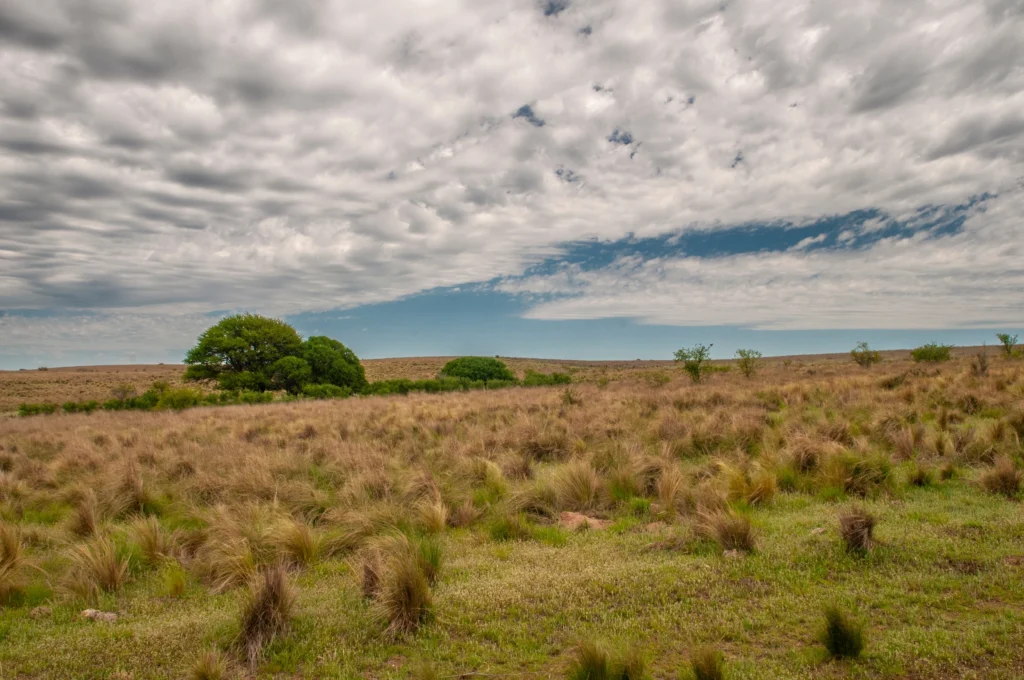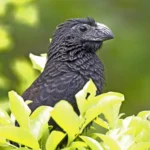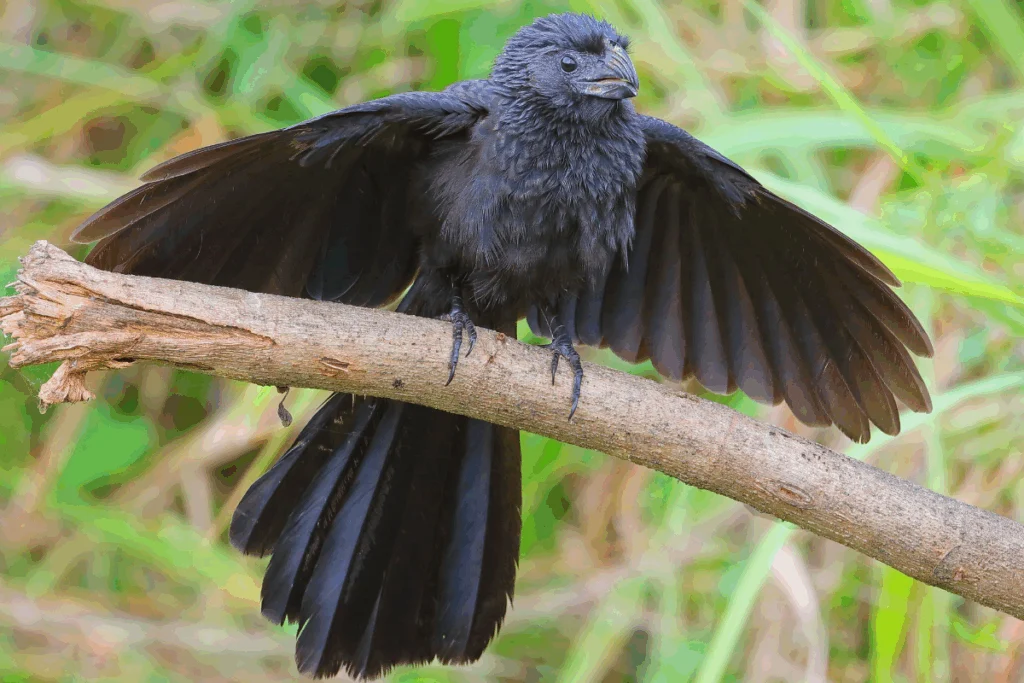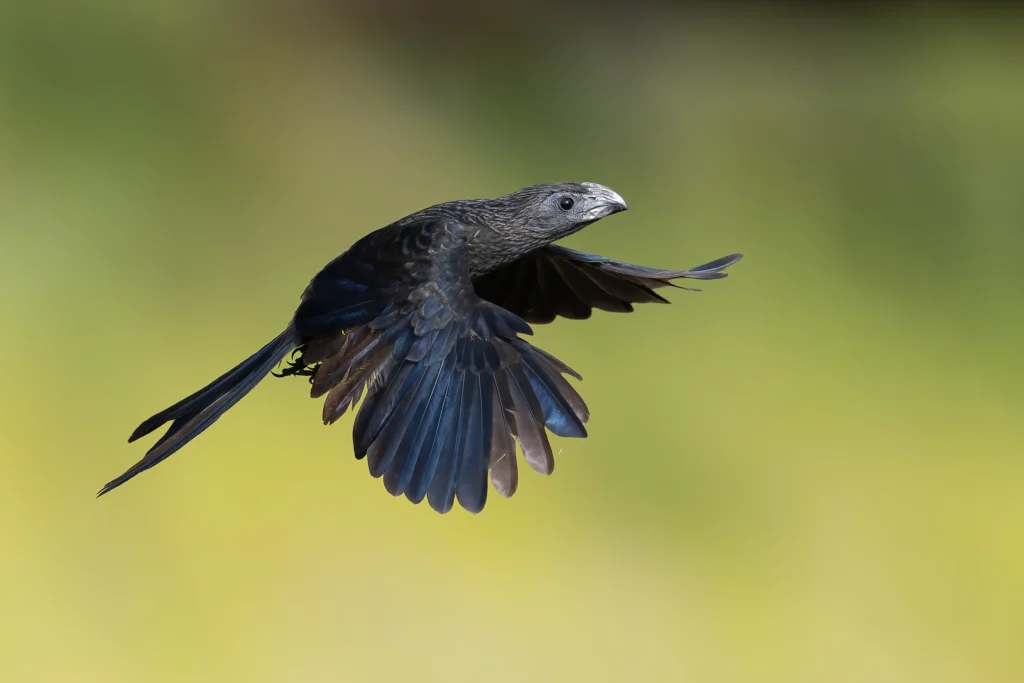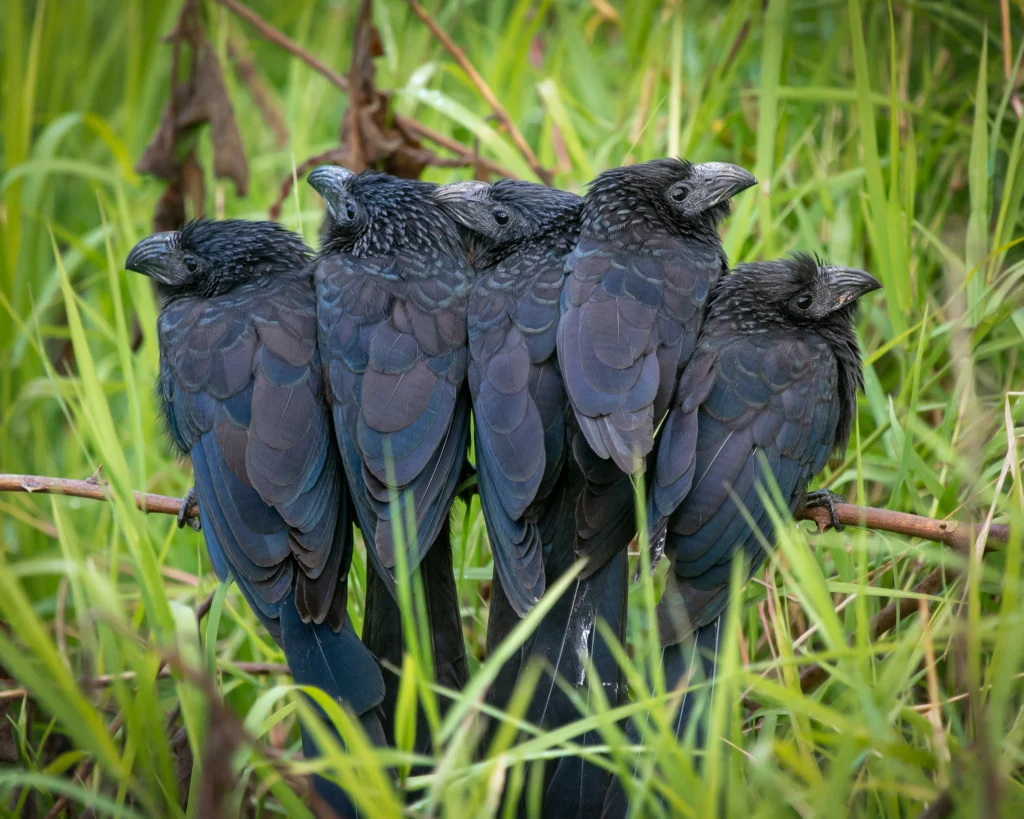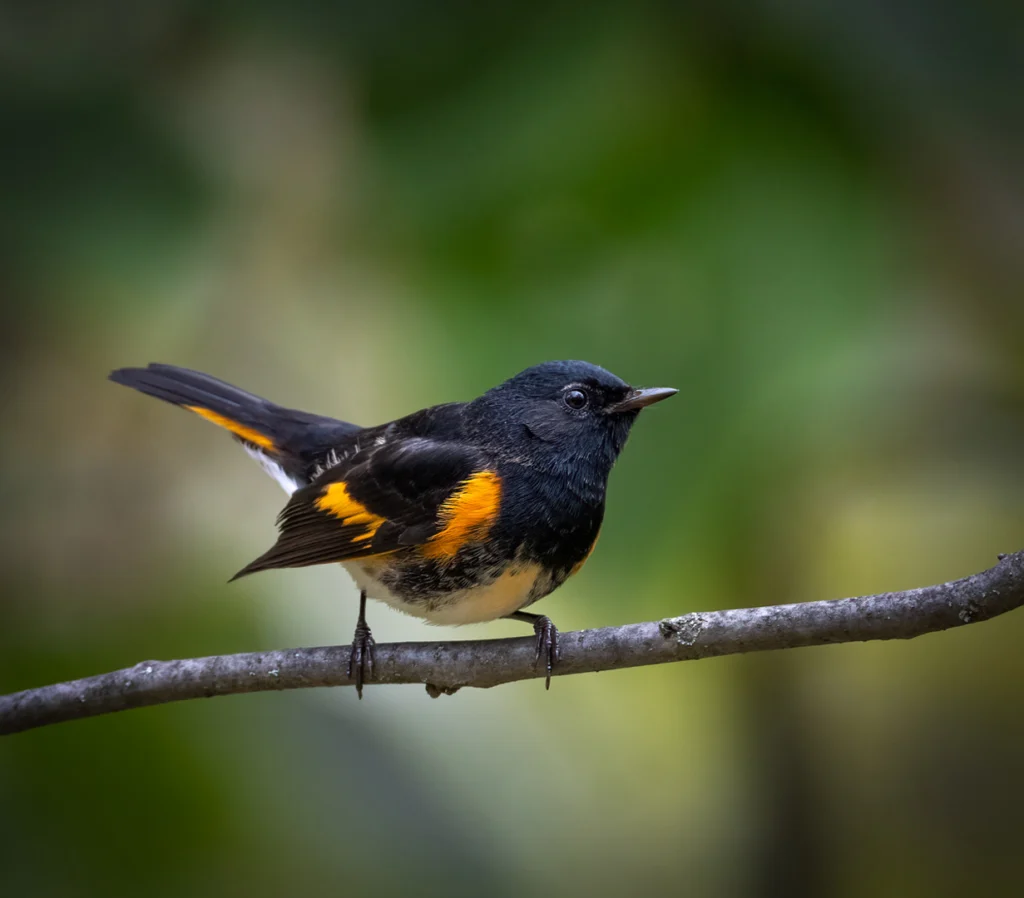
Overview
About
As renowned naturalist Alexander Skutch once remarked: “Although the anis have much to recommend them to the attention of the naturalist, it is not by their beauty that they attract him.”
With its rumpled appearance and ungainly movements, the Groove-billed Ani might not be the most beautiful bird, but it is no doubt a fascinating species. Its highly-arched, grooved beak inspired its species name sulcirostris, a combination of the Latin words for “groove” and “beak.” Its genus name, Crotophaga, comes from Greek and Latin words for tick and eating, reflecting its insect-heavy diet, which is a bit misleading.
Groove-billed Anis are thought to eat a tick-heavy diet, primarily plucked from cattle, but it’s more likely they are frequently spotted around cattle for the same reason Cattle Egrets are: Cattle stir up the grasshoppers and other insects these birds love to eat. Still, their perceived penchant for ticks and other insects inspired another folk name, garrapater (literally “tick-eater”) in parts of Central America.
A member of the cuckoo family, the Groove-billed Ani is related to the Yellow-billed Cuckoo and Greater Roadrunner.
Threats
Birds around the world are declining, and many species face urgent threats. Even bird species that still seem numerous, such as Groove-billed Ani, are made more vulnerable by the cumulative impacts of threats like habitat loss and pesticide use.
Habitat Loss
While some types of habitat modification can actually create habitat beneficial for the Groove-billed Ani, habitat loss, along with fragmentation and degradation, can contribute to population declines of even common birds.
Collisions
The Groove-billed Ani readily uses human-modified habitat, including agricultural fields and pastures, which can bring it closer to other threats, like fatal collisions with cars and other vehicles.
Pesticides & Toxins
The Groove-billed Ani runs the risk of both direct and indirect poisoning as it forages for insects in pesticide-treated agricultural fields. Pesticide use can also deplete insect populations.
Conservation Strategies & Projects
Birds need our help to overcome the threats they face. At ABC, we’re inspired by the wonder of birds and driven by our responsibility to find solutions to meet their greatest challenges. With science as our foundation, and with inclusion and partnership at the heart of all we do, we take bold action for birds across the Americas.
Create & Maintain Reserves
Creating nature reserves has been a hallmark of ABC since 1998, when we helped Mexican partner Bosque Antiguo establish the El Carricito reserve to protect the Thick-billed Parrot and Military Macaw in western Mexico. The Groove-billed Ani can be found at this reserve and many other ABC reserves and protected areas, including El Dorado in Colombia, Buenaventura and Yunguilla in Ecuador, and Sierra Carel in Guatemala.
Avoid Pesticides & Toxins
ABC works with partners to call for the regulation or cancellation of the pesticides and toxins most harmful to birds. We develop innovative programs, like working directly with farmers to use neonicotinoid coating-free seeds, advancing research into pesticides’ toll on birds, and encouraging millions to pass on using harmful pesticides.
Bird Gallery
Naturalist Alexander Skutch sketches a vivid word picture of the Groove-billed Ani: “(Its) black bill is narrow and very high, with the upper mandible strongly arched and furrowed lengthwise by parallel curved ridges and channels. Its black face is largely bare of feathers, and prominent lashes shade its dark, beady eyes. Its plumage is everywhere black, but the feathers on its neck present a scaled appearance, while greenish and purplish glints play over its body and wings in the sunshine and redeem the black monotony of the bird.”
This species appears lean and lanky, with a long, frayed, floppy-looking tail. Its loose, clumsy-looking flight style consists of short flaps and glides.
Both sexes of Groove-billed Ani look alike, and their plumages stay the same year-round. Juveniles are similar to adults, but with dull black and brown plumage and a smaller bill without grooves.
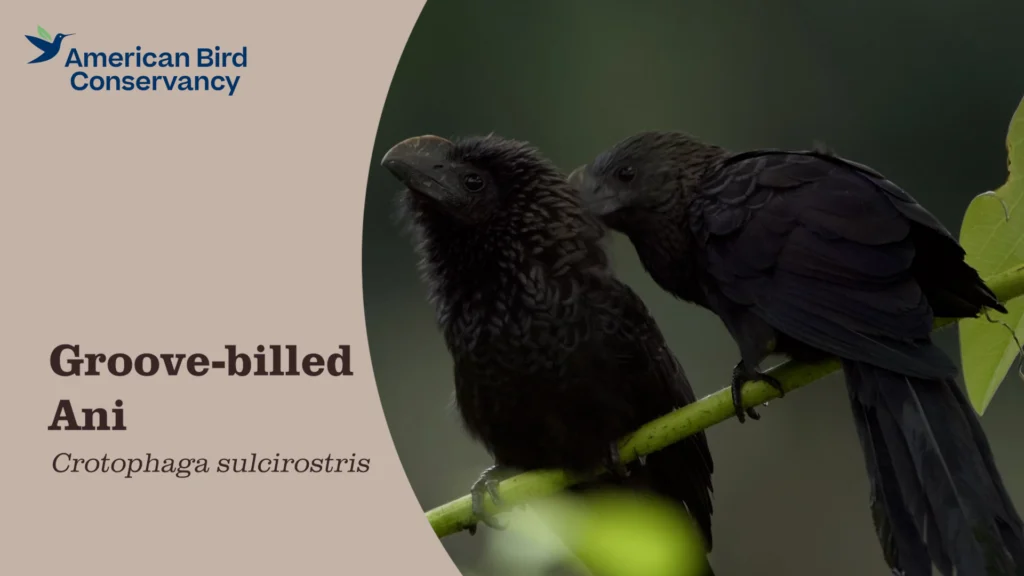
Sounds
The Groove-billed Ani’s squeaky, two-syllable call notes, which sound like tijo-tijo or pihuy-pihuy, inspired this bird’s common name in several countries.
Credit: Étienne Leroy, XC955149. Accessible at www.xeno-canto.org/955149.
Credit: Cristopher Rodriguez-Moreira, XC767445. Accessible at www.xeno-canto.org/767445.
Habitat
The Groove-billed Ani breeds in dry savannas, fields, and other open habitats with scattered trees. During the nonbreeding season, it joins larger flocks and moves to wetter habitats in marshes and riparian areas.
- Breeds in open fields, meadows, grass and shrublands, and savannas
- Dense, thorny thickets and undergrowth
- Marshes and riverbanks during the nonbreeding season
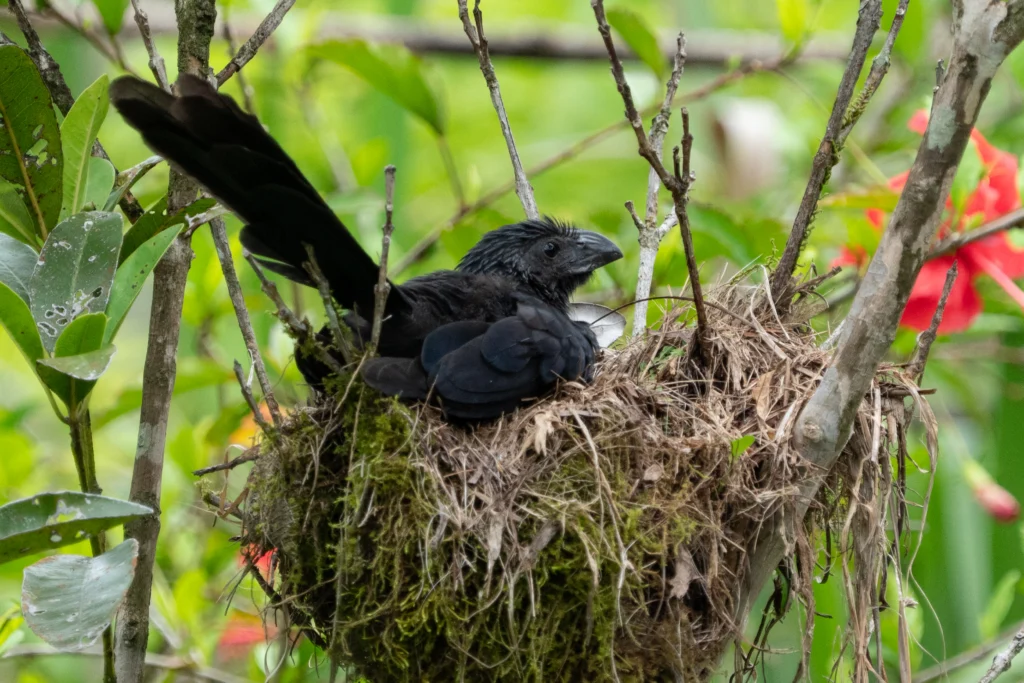
Range & Region

Specific Area: North and South America
Range Detail:
The Groove-billed Ani breeds from south Texas through southern Sonora, Zacatecas, central San Luis Potosí, and northeast Coahuila in Mexico. These birds spend the nonbreeding season along the Gulf Coast of Texas and Louisiana.
Most populations of Groove-billed Ani are resident, ranging from Mexico through all the countries of Central America and into northern and western South America, including Guyana, Venezuela, Colombia, Ecuador, Peru, and Chile.
Did you know?
The Groove-billed Ani shows variable migratory behaviors. Populations in Mexico, Central, and South America appear to be resident, with some moving to wetter areas during the nonbreeding season. Groove-billed Anis breeding in Texas appear to migrate north along the Gulf Coast to Louisiana and Mississippi during the nonbreeding season.
Life History
Highly social, the Groove-billed Ani can usually be seen perched or foraging in groups. Perched birds nestle close together and solicitously preen each other. When its plumage gets wet, a Groove-billed Ani will perch with wings spread to dry in the sun, looking like a small Turkey Vulture or Anhinga.

Diet
The Groove-billed Ani feeds on grasshoppers, crickets, other insects, spiders, and small vertebrates, which they capture as they walk or hop through vegetation. In open pasturelands, Groove-billed Anis can often be seen following domestic livestock, snatching up prey disturbed by the larger animals as they graze. They follow ant swarms for the same reason.
Courtship
In lieu of specific courtship behavior, Groove-billed Anis form monogamous pairs within breeding groups that range from one to five pairs, which defend a single territory. Most groups contain an equal number of males and females. Pairs often remain together for multiple breeding seasons.
Nesting
The Groove-billed Ani builds its nest in dense, thorny foliage in a tree or bush near open space, often close to a wasp nest, which may serve as extra protection from predators. Its nest may also be built amid a dense tangle of vines. The nest is a shallow, bulky, bowl made from twigs, dead vines, and other vegetation, lined with a thick layer of fresh green leaves. All members of the breeding group work together to build the nest.
Eggs & Young
All the female Groove-billed Anis in a breeding group lay their eggs in a single nest. The clutch size can range from three to 20 eggs, depending on the number of females in the group. A female will remove the eggs of other females in the group before beginning to lay her own; this behavior ensures that the number of eggs ultimately incubated is more manageable than it would otherwise be if every egg laid were incubated. The entire group cooperates to incubate the joint clutch for about two weeks until hatching. After hatching, the young anis are fed and cared for by the entire group, and fledge after 10 to 11 days. Young birds stay close to the territory and their natal group, often helping to raise young from successive clutches.
